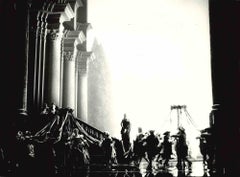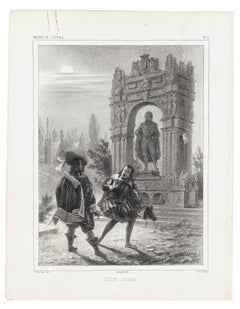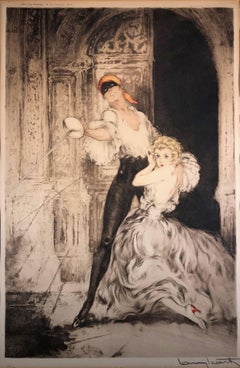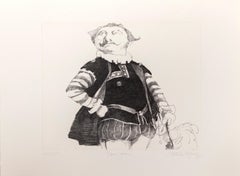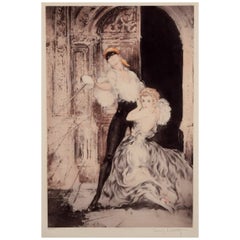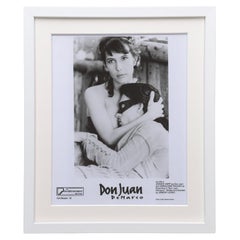Don Juan
to
11
61
36
40
30
22
20
14
11
10
9
9
8
8
8
6
5
5
3
3
3
2
2
2
2
2
2
2
2
2
1
1
1
1
1
1
1
1
1
3
3
2
2
2
Sort By
Don Juan - Vintage Photo - 1980s
Located in Roma, IT
Vintage photograph representing Mozart's Don Juan, by Lelli & Masotti at Teatro alla Scala Milano.
Category
1980s Contemporary Figurative Photography
Materials
Photographic Paper
Don Juan - Lithograph - Mid 19th Century
By Charles Deshays
Located in Roma, IT
Don Juan is an original lithograph, realized by C. Deshays in between 1838 -1850, titled below in
Category
Mid-19th Century Figurative Prints
Materials
Lithograph
$284
H 8.47 in W 10.63 in D 0.08 in
Don Juan
By Louis Icart
Located in Missouri, MO
Aquating Engraving
Image Size: approx. 20 1/4 x 13 3/8
Framed Size: 28 x 20.5 inches
Pencil Signed Lower Right
Louis Justin Laurent Icart was born in Toulouse in 1890 and died in Pa...
Category
1920s Art Deco Figurative Prints
Materials
Engraving, Aquatint
Francisco Araiza in "Don Juan" - Vintage Photo - 1980s
Located in Roma, IT
Vintage black and white photograph realized in 1980s.
It shows a representation of Don Juan at
Category
1980s Contemporary Figurative Photography
Materials
Photographic Paper
Don Juan, Folk Art Etching by Charles Bragg15.5
By Charles Bragg
Located in Long Island City, NY
Charles Bragg, American (1931 - 2017) - Don Juan, Year: circa 1970, Medium: Etching, signed
Category
1970s Folk Art Figurative Prints
Materials
Etching
Poul Esting, Don Juan, Color Lithograph, Framed
Located in Warszawa, Mazowieckie
Poul Esting, Don Juan
Color lithography
Number 6/36
Work with signature and individual number
Category
Vintage 1980s Danish Scandinavian Modern Decorative Art
Materials
Paper
Louis Icart. Color lithograph on paper. Don Juan. 1920s.
Located in København, Copenhagen
Louis Icart (1888-1950). Color lithograph on paper.
Don Juan.
1920s.
Signed in pencil.
In perfect
Category
Vintage 1920s French Prints
Materials
Paper
Parker Panttila "Passion Eclipsing Enlightenment Don Juan" Watercolor
Located in Brooklyn, NY
Enlightenment Don Juan.'
Surrealist in style, evoking the symbolists like Gustav Klimt, whose works were also
Category
Vintage 1970s American Paintings
Materials
Paint
$900
H 19.25 in W 19.25 in D 0.25 in
Don Juan DeMarco 1994 Publicity Film Movie Press Still Framed
Located in Bath, Somerset
Original 8x10 inches Publicity Film Still for Don Juan DeMarco (1994) starring Johnny Depp, Marlon
Category
20th Century American Posters
Materials
Paper
Don Juan DeMarco 1994 Publicity Film Movie Press Still Framed
Located in Bath, Somerset
Original 8x10 inches Publicity Film Still for Don Juan DeMarco (1994) starring Johnny Depp, Marlon
Category
20th Century American Posters
Materials
Paper
Don Juan - Cosi Fan Tutte - China Ink and Pencil by A. R. Hallman - 20th Century
Located in Roma, IT
Don Juan - Cosi Fan Tutte is an original drawing in pencil and China ink on ivory-colored paper
Category
Early 20th Century Modern Figurative Drawings and Watercolors
Materials
Ink, Tempera
$889
H 14.57 in W 11.62 in D 0.04 in
"The Adventures of Don Juan" or "Le Avventure Di Don Giovarri" Film Poster
By Luigi Martinati
Located in London, GB
Original Italian film poster for Don June. This was Errol Flynn's last big budget.
Movie and a perfect role for Flynn. The poster features beautiful artwork by the renowned Italian ...
Category
Vintage 1940s Italian Posters
Materials
Paper
$2,671
H 55 in W 39 in D 0.1 in
Les Exploit d'un Jeune Don Juan - Rare Book Illustrated by Apollinaire - 1910
Located in Roma, IT
Edition of 137 copies including 12 original lithographs.Copy on Rives B.F.K., with lithographs on vélin d'Arches. Original soft cover, includes slipcase. Slipcase with some stains in...
Category
1910s Surrealist More Art
Materials
Paper
$1,126
H 9.65 in W 7.68 in D 0.2 in
18th C Engraving Jesús Nazareno by Juan Antonio Salvador Carmona
Located in West Palm Beach, FL
Engraving of Jesús Nazareno by Juan Antonio Salvador Carmona, dedicated to the Duke of Medina Celi
Category
Antique Late 18th Century Spanish Baroque Prints
Materials
Velvet, Glass, Giltwood, Paper
Antique Bronze Bust of Lord Byron
Located in Wormelow, Herefordshire
esteemed for the satiric realism of fictional character Don Juan.
Category
Antique Late 19th Century French Victorian Busts
Materials
Metal, Bronze
Clash at Rijmenam Engraved: A Turning Point in the Eighty Years' War, 1632
Located in Langweer, NL
François de la Noue.
Don Juan of Austria, the Spanish commander, commanded an army of 12,000 infantry and
Category
Antique 1630s Prints
Materials
Paper
$746 Sale Price
25% Off
H 13.9 in W 17.92 in D 0 in
Original 1934 Leningrad Music Hall Theatre Poster for the Seducer of Seville
Located in London, GB
the legend of Don Juan. Colorful Constructivist design featuring a man from the clergy wearing red
Category
Vintage 1930s Russian Posters
Materials
Paper
$7,533
H 38 in W 27.96 in D 0.04 in
Bronze Mortar with Inscription, Spain, 1816
Located in Madrid, ES
in pilasters and a stripe in the upper area with an inscription (I am from Don Juan Antonio Martínez
Category
Antique 1810s Spanish Neoclassical Revival Scientific Instruments
Materials
Bronze
Flowerpot cachepot jardiniere Romance worldexhibition? Romeo Juliet 1900 Germany
By Fischer & Mieg Pirkenhammer
Located in Wien, AT
, decipting children showing Don Juan and on the other side Romeo and Juliet. The protagonists are dressed in
Category
Antique Early 1900s Romantic Planters, Cachepots and Jardinières
Materials
Porcelain
$850
H 7.48 in W 8.27 in D 8.27 in
Antique Print of Portuguese Prisoners Building a Palace in Ceylon or India, 1672
Located in Langweer, NL
Antique print of Portuguese prisoners building a palace and other new buildings for Don Juan. This
Category
Antique 17th Century Prints
Materials
Paper
$170 Sale Price
20% Off
H 12.01 in W 7.49 in D 0 in
I Don´t Eat Fish
By Juan Jose Garay
Located in LAS ROZAS DE MADRID, ES
Work signed on front and back
It is sent in a tube
Category
21st Century and Contemporary Abstract Expressionist Abstract Paintings
Materials
Enamel
Rare Print of the Siege of Doornik Between the English and French Armies, c.1680
Located in Langweer, NL
and Engravers: Engraved by R. de Hooghe after Don Juan de Ledesma.
Condition: Fair, age-related
Category
Antique 17th Century Prints
Materials
Paper
$436 Sale Price
20% Off
H 11.23 in W 13.78 in D 0 in
Antique Print of D. Tenier with his Pupil by Madou, 1842
Located in Langweer, NL
Antique print titled 'David Teniers avec son Élève Don Juan d'Autrighe (..)'. Antique print
Category
Antique 19th Century Prints
Materials
Paper
$208 Sale Price
20% Off
H 16.34 in W 23.04 in D 0 in
Le Troisieme Oeil (The Third Eye) plate #9
By Marcel Marceau
Located in San Francisco, CA
world. Among the many original performances he has devised are the mime-drama Don Juan (1964), and the
Category
Late 20th Century Modern Figurative Prints
Materials
Lithograph
Silver Two-Handled Cup '“bernegal”', 17th-18th Century
Located in Madrid, ES
couple of Antonio López Díaz (made in Jaén and dated 1758/1772) from the Valencia Institute of Don Juan
Category
Antique 18th Century Spanish Baroque Sterling Silver
Materials
Sterling Silver
Le Troisieme Oeil (The Third Eye) plate #4
By Marcel Marceau
Located in San Francisco, CA
throughout the world. Among the many original performances he has devised are the mime-drama Don Juan (1964
Category
Late 20th Century Modern Figurative Prints
Materials
Lithograph
Ca. 1578 Old Master Engraving "Siculus" After Jan vander Straet (Strandanus)
By Jan Van der Straet
Located in Chicago, IL
of a 39-part series about the royal stables of Don Juan of Austria. Early Impression before changing
Category
16th Century Old Masters Animal Prints
Materials
Engraving, Paper
Reliquary Cross Pendant, Silver, Glass, 17th-18th Century
Located in Madrid, ES
Foundation of Don Juan in Madrid, the National Museum of Decorative Arts (Madrid), the Lázaro Galdiano
Category
Antique 18th Century European Neoclassical Religious Items
Materials
Silver
Poetical Works of Percy Bysshe Shelley with Harrison & Son Binding
By Percy Bysshe Shelley
Located in valatie, NY
sailing boat, the Don Juan. After Percy's death his second wife Mary Shelley devoted herself to writing
Category
Antique 19th Century English Books
Materials
Paper
$1,950 / set
H 8.5 in W 6 in D 7 in
Reliquary Pendant, Flagellation of Christ, Silver, Enamel, 16th Century
Located in Madrid, ES
Valencia Foundation of Don Juan in Madrid, the Museum National Decorative Arts of the same city, etc., or
Category
Antique 16th Century European Renaissance Religious Items
Materials
Silver, Enamel, Other
$4,564
H 3.94 in W 3.15 in D 0.4 in
Rare Large 1650 Copper Engraving Depicting the Naval Battle of Gibraltar, 1607
Located in Langweer, NL
, including their commander Don Juan Alvarez de Avila.
The engraving showcases incredible detail, with
Category
Antique 1650s Prints
Materials
Paper
$2,003 / item
H 14.45 in W 34.45 in D 0.01 in
Astrology Fantasy - "A Love by the Stars" - Sci-Fi Alignment of the Planets
Located in Miami, FL
as such Simon & Schuster publications as Carlos Castaneda's The Teachings of Don Juan and A Separate
Category
1970s Surrealist Landscape Paintings
Materials
Cotton Canvas, Acrylic
$50,000
H 36 in W 28 in D 2 in
Double Fugue #3 - painting, abstract, contemporary, acrylic on canvas
By Burton Kramer
Located in Bloomfield, ON
wrote in Conversations with Don Juan... "how does she dance? She dances with everything she has. That's
Category
2010s Abstract Abstract Paintings
Materials
Canvas, Acrylic
Pair of Miniatures, Frans van de Casteele 'Kasteels' aka Francesco da Castello
By Francesco da Castello
Located in Madrid, ES
box with compartments with the Tree of Jesse conserved in the Institute of Valencia de Don Juan de
Category
Antique Early 17th Century European Baroque Decorative Art
Materials
Other
$23,119 / set
H 11.23 in W 9.26 in D 3.15 in
Votive lamp. Silver in its color. Cadiz, 18th century (1767).
Located in Madrid, ES
, record location Jalapa) in which Don Manuel José de Alba is mentioned, the legitimate son of Don Juan
Category
Antique 18th Century Spanish Rococo Religious Items
Materials
Silver, Other
Realist Painting Portrait French actor Comedie Française LARD 19th
Located in PARIS, FR
Caprices of Marianne, Louis XIII in Marion Delorme, Dom Juan in Henri III and his Court). Appointed
Category
1890s French School Portrait Paintings
Materials
Oil
$2,786
H 21.66 in W 14.97 in
Mexican Artist Laurencia Evans Oil Painting on Canvas, Signed, Titled and Dated
Located in Miami, FL
Juan, a yaqui witch from the Sonora desert in Mexico. I also really like Ursula K. Le Guin and other
Category
Late 20th Century Mexican Modern Paintings
Materials
Canvas, Wood, Giltwood, Paint
$3,800 Sale Price
20% Off
H 30 in W 40 in D 1.5 in
1960s William Travilla Green and Blue Sequin Dress
By William Travilla
Located in London, GB
Itch' and was Oscar nominated 5 times winning for 'The Adventures of Don Juan' where he designed
Category
1960s American Evening Dresses
Personages with Lambs
By Sylvain Sauvage
Located in San Francisco, CA
Don Juan d’Edmond Rostand, éditions Pierre Laffitte, 1939 ; illustrations de Auguste Leroux, (Bandeaux
Category
Early 20th Century Art Nouveau Figurative Prints
Materials
Aquatint
Street After Rain (Santiago de Chile) Dominican Artist
Located in Wilton Manors, FL
collections
Queen Sofia Museum, Madrid, Spain
Royal Palace of the Honorable Don Juan Carlos I and Doña Sofía
Category
1970s Abstract Impressionist Landscape Paintings
Materials
Masonite, Oil
$1,500 Sale Price
25% Off
H 26 in W 30 in D 1 in
Myth of Sisyphus I (I think at this point of all those who absolutely insist..)
By Vivian Liddell
Located in Gilroy, CA
"Myth of Sisyphus I (I think at this point of all those who absolutely insist that Don Juan be
Category
2010s Contemporary Abstract Paintings
Materials
Oil Pastel, Acrylic
Trazos Levitantes
By Rafael Barrios
Located in Miami, FL
Imber's Caracas Museum of Contemporary Art; the private collections of HRH Don Juan Carlos de Borbón, King
Category
1990s Kinetic Abstract Sculptures
Materials
Stainless Steel
Devotional Pendant, Oil on Aventurine, Gold, Enamel, Spain, 17th Century
Located in Madrid, ES
gold triangular pendant from the Don Juan de Madrid Institute of Valencia.
Weight: 103 grams."
Size
Category
Antique 17th Century Spanish Baroque Religious Items
Materials
Gold, Enamel, Other
$11,856
H 0.28 in W 3.55 in D 3.15 in
Rafael Barrios, Movil Espiral Fractal, 2019, Aluminum, Edition 3/3
By Rafael Barrios
Located in Miami, FL
Caracas Museum of Contemporary Art; as well as in the private collections of HRH Don Juan Carlos de Borbón
Category
2010s Kinetic Abstract Sculptures
Materials
Metal
Price Upon Request
H 70.08 in W 31.5 in D 31.5 in
Ferjo - Surrealist Interior - Signed Oil on Canvas
By Ferjo
Located in Collonge Bellerive, Geneve, CH
strangely out of sync. Yet the lack of synchronicity is part of artist’s manipulation. Just as Don Juan
Category
1990s Surrealist Interior Paintings
Materials
Oil
Travilla for Saks Fifth Ave Beverly Hills Beaded Lace and Silk Gown Size 16 NWOT
By William Travilla, Travilla
Located in Palm Springs, CA
Adventures of Don Juan (1948) in conjunction with Leah Rhodes and Marjorie Best. After his three year
Category
1980s American Evening Dresses
"The Barber of Seville", Early 20th Century Oil on Canvas by José Villegas
Located in Madrid, ES
Juan de Austria's last visit to Felipe II, all of them of excellent workmanship.
From 1877 on, he
Category
1910s Realist Figurative Paintings
Materials
Canvas, Oil
$9,485
H 19.3 in W 28.75 in
"The Florence Sisters", 19th Century Oil on Canvas, Spanish Artist José Villegas
Located in Madrid, ES
such as La paz de Cambray and Don Juan de Austria's last visit to Felipe II, all of them of excellent
Category
Late 19th Century Realist Figurative Paintings
Materials
Canvas, Oil
$10,670
H 33.27 in W 40.36 in
Portraits of the monarchs Louis XIII and Anne-Marie of Austria as hunters.
Located in Madrid, ES
, trained in Valladolid under Patricio Cajés, was also a pupil of Juan Pantoja de la Cruz, whom he succeeded
Category
Antique 17th Century Spanish Baroque Paintings
Materials
Other
$113,821 / set
H 84.26 in W 45.28 in D 1.97 in
Mouvement Spatiale, 1962 - crayon, 80x130 cm., framed.
Located in Nice, FR
dandy, a Don Juan. Most of all he devoted himself to making his art the ideal of a life freed of any
Category
1960s Surrealist Abstract Drawings and Watercolors
Materials
Crayon
$5,335
H 31.5 in W 51.19 in
LePoittevin Eugene - Italianate Landscape with a woman - oil on canvas - signed
Located in PARIS, FR
year. At the 1848 Salon, his work "David Teniers conduisant Don Juan D'Autriche" was met with severe
Category
Mid-19th Century Realist Landscape Paintings
Materials
Oil
$3,130
H 12.6 in W 9.06 in D 3.35 in
Eugène Lepoittevin. A drawing lesson by the Sea - oil on canvas - signed 1853
Located in PARIS, FR
year. At the 1848 Salon, his work "David Teniers conduisant Don Juan D'Autriche" was met with severe
Category
Mid-19th Century Realist Landscape Paintings
Materials
Oil
Antique French Gilt Bronze Clock with Portrait Plaque of Molière 19th Century
Located in London, GB
roundly received condemnations from the Church, while Don Juan was banned from performance. Molière's hard
Category
Antique 1860s French Mantel Clocks
Materials
Bronze
$5,136
H 13.39 in W 20.48 in D 5.52 in
1950s DRIVE-IN MOVIE THEATER POSTER "Don Juan's Night of Love"
Located in Chicago, IL
more amorous "Don Juan's Night of Love".
From a collection of posters found in a Kansas
Category
Vintage 1950s American Posters
BYRON'S POETICAL WORKS - DON JUAN
By Veronica Bailey
Located in Lucerne, CH
HOURS OF DEVOTION Series 2007
STATEMENT
In 2006, Coutts & Co, one of the oldest and most prestigious banking firms in London, commissioned the artist, Veronica Bailey, to explore...
Category
Early 2000s Contemporary Still-life Photography
Materials
Lambda
Original 1934 Leningrad Music Hall Theatre Poster For The Seducer Of Seville
Located in London, GB
the legend of Don Juan. Colourful Constructivist design featuring a man from the clergy wearing red
Category
1930s Constructivist More Prints
Materials
Paper
$7,533
H 38 in W 27.96 in
Equestrian Marble Sculpture by Luis Antonio Sanguino in Rosso Alicante Marble
By Luis Sanguino
Located in Portland, OR
Don Juan Carlos II for his work creating monuments around the country. Currently, the artist lives and
Category
Late 20th Century Spanish Other Figurative Sculptures
Materials
Marble
$5,495
H 33 in W 32 in D 16 in
Madman's Passion
By Juan Gastelium
Located in Nashville, TN
The bronze sculpture is a contemporary version of Don Quixote by Juan Gastelium. It is signed and
Category
21st Century and Contemporary American Sculptures
- 1
Get Updated with New Arrivals
Save "Don Juan", and we’ll notify you when there are new listings in this category.
Don Juan For Sale on 1stDibs
Surely you’ll find the exact don juan you’re seeking on 1stDibs — we’ve got a vast assortment for sale. You can easily find an example made in the contemporary style, while we also have 19 contemporary versions to choose from as well. If you’re looking for a don juan from a specific time period, our collection is diverse and broad-ranging, and you’ll find at least one that dates back to the 18th Century while another version may have been produced as recently as the 21st Century. When looking for the right don juan for your space, you can search on 1stDibs by color — popular works were created in bold and neutral palettes with elements of black, gray, brown and white. There have been many interesting don juan examples over the years, but those made by KOLLABS, Vanessa Marsh, Teresa Smith, Georges Artemoff and Christian Gaillard are often thought to be among the most thought-provoking. Artworks like these — often created in paint, oil paint and fabric — can elevate any room of your home.
How Much is a Don Juan?
The price for a don juan in our collection starts at $77 and tops out at $105,038 with the average selling for $2,444.
More Ways To Browse
Kitchen Pottery
Hand Painted Pottery
Antique World Maps
Vintage Glazed Pottery
Black On Black Pottery
Vintage Pottery 1970s
Sequin Dress
Antique Cachepot
Blue Dresses And Gowns
Black Vintage Pottery
Vintage Signed Pottery
Blue And Green Dress
Green And White Dress
Religious Jewlery
18th Century French Gilt Bronze Furniture
Used Church Items
Green Evening Dress
Red Green Dress
